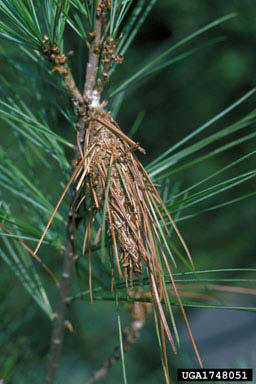
Host: Cedar and arborvitae, occasionally pines and hardwoods.
Importance: Although primarily an enemy of ornamentals, large populations can build up in stands of eastern red cedar and Atlantic white cedar. Complete or repeated defoliation kills the tree. Under normal conditions, attacks in natural stands are limited to single trees. The bagworm is not a major forest pest.
Identification: The adult male moth has a wingspan of about one-inch and his wings are almost transparent. The body is slender, black and hairy, and the antennae are broadly feathered. The adult female is wingless, legless and yellow-white in color. The larvae are about one-inch when fully-grown, and dark brown with a yellowish head and thorax covered with black spots. Pupae are brownish and enclosed in the bag. Eggs are small, white and laid in the pupal case.
Signs of Attack: The most noticeable sign of attack is a bag or case composed of silk, twigs, and other debris. When infestations are heavy, the host may be partially or completely defoliated. The case of mature larvae may be as long as two inches.
Life Cycle: Male moths emerge and fly to the female cases to mate during late summer or early fall. Each female deposits 800 to l,000 eggs in the bag and then her shriveled remains drop to the ground and die. Eggs remain in the bag over winter. In late spring, eggs hatch and each larva immediately makes a small case in which it lives throughout its larval life. As larvae grow, they enlarge the cases to accommodate their increasing size. In order to feed or move about, larvae must partially emerge so heads and thoracic legs are exposed. Pupation occurs within bags during late summer and moths emerge about three weeks later. There is one generation per year in Alabama.
Control: Predators, parasites, and other natural control factors usually prevent build up of large populations. Forest control: Chemical control not recommended. Shade tree control: Residential trees may become heavily infested and require insecticide applications. Spray foliage with 0.5% malathion (mix 6 1/2 pints of 57% malathion E. C. with 100 gal. of water, or 2 T/gal according to label directions and state law). Hand picking and burning cases may be the easiest control method, particularly when only a few infested trees are involved. When pulled out of their bags, larvae make excellent fish bait.
Photo Credit: Robert L. Anderson, USDA Forest Service, ForestryImages.Org
Additional Resources